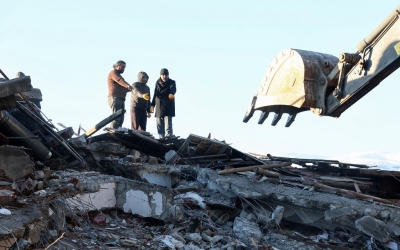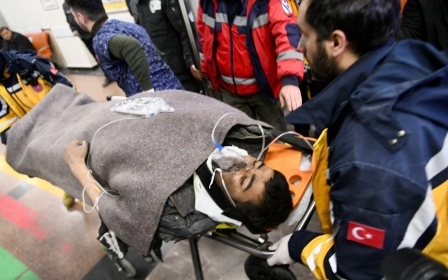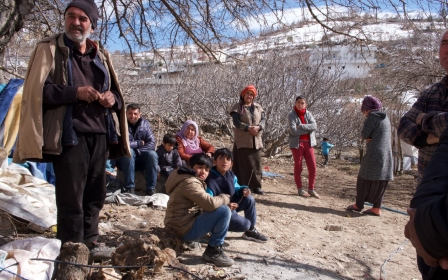'Very simple things': Earthquake engineers on what went wrong in Turkey

Smooth pebbles in concrete. Steel hoops out of place. These are the small, but telling clues that Kit Miyamoto spotted in earthquake debris in Turkey this week that reveal what went wrong.
"They have 90 percent right, 10 percent wrong," said Miyamoto, a structural engineer who has toured the aftermath of some of the world's worst earthquakes over the past 20 years.
"The problem with 10 percent wrong? An earthquake is not forgiving. It will kill you."
There is universal agreement that the earthquake that hit Turkey and Syria earlier this month was one of the most powerful in almost a century - only to be followed just hours later by another one, large in its own right. But now in question is how the scale of destruction could have been prevented.
Out of the rubble of every major earthquake since the 1970s has come ever-improving designs to reduce the risk of building collapse.
The main goal? Enable a structure to accommodate the massive forces released from the earth, says Ziggy Lubkowski, the leader of the seismic team for the global engineering firm, Arup.
"The basic method is to design a frame or wall structure that is sufficiently elastic to absorb the force in all directions yet strong enough to remain standing," he said.
"Alternatively, we can put the building on bearings to accommodate the lateral forces or include dampers to absorb earthquake energy."
While materials differ, these methods are roughly the same across the globe. What works in California works in Japan, in New Zealand and, also, in Turkey, where its universities have a reputation for turning out highly qualified earthquake engineers and practitioners.
So why has the country seen such an enormous scale of destruction, and was that scale preventable?
Glacial pace
It's still early days to say exactly what happened and why, but six structural engineers who spoke with Middle East Eye say it's a fair assessment that buildings - old and new - did not perform as well as they would have expected, even factoring in the exceptional power of the quakes.
One issue will likely be that older buildings - particularly ones made from lightly reinforced concrete masonry, a material usually avoided nowadays in earthquake zones - were not retrofitted, especially residential blocks.
The financing typically available to retrofit public buildings like hospitals and schools is hard if not impossible for governments to match. "No government can fix private buildings. It's just impossible. There is not enough tax money to do that," said Miyamoto.
'The recurrence intervals of major disasters is longer than people's memory in this country'
- Polat Gulkan, Turkish engineer
In 2021, the World Bank estimated that retrofitting the housing stock in Turkish cities built before 2000 - a year after the devastating Izmit earthquake which killed more than 17,000 people - would cost half a trillion dollars.
At that time, only four percent of the 6.7 million residential buildings had been updated.
"The cost of upgrading existing subpar buildings causes the effort to proceed at a glacially slow pace," three experts, including Turkish earthquake engineer Polat Gulkan, wrote this week.
Gulkan warned in 2005 that lessons had not been learned after the 1999 earthquake and that, while reconstruction happened quickly after, the system regulating planning and construction was chaotic and had not been fixed vigorously enough to mitigate against future disasters.
Public pressure, he wrote, had dissipated to bring out the necessary changes to rule out a repeat of the 1999 calamity. On Friday, he echoed a similar sentiment. "The recurrence intervals of major disasters is longer than people's memory in this country," he told MEE.
'Make or break'
There were similar questions among structural engineers this week about lessons learned, given the collapse of newer buildings, including those after Turkey updated its seismic code in 2018.
That code is considered "as good as any in the world", said Arup's Lubkowski.
But since the quakes, there has been growing anger that zoning amnesties in recent years, including some pushed through ahead of elections, allowed contractors to throw up buildings flaunting that code and others with no fear of penalty.
Mehrdad Sasani, a professor of civil and environmental engineering at Northeastern University in Boston, said that from what he observed, the most likely cause of newer buildings falling was bad construction and poor enforcement of codes and standards.
After the 1999 earthquake, he saw a photo of a bucket found inside a concrete column. "That's poor construction," he said. He wouldn't expect to see that again, but the point is that subtle details really matter when reinforcing buildings against quakes.
"You need to pay attention to it and do it properly. Does it cost a lot? No, compared to the building, it doesn't cost a lot. But it could pretty much make or break a building," he said.
And it's small mistakes that Miyamoto, chief executive of the US-based Miyamoto International structural engineering and disaster-risk reduction firm, says he's spotting as he tours the impact area in Turkey.
Unlike in California or Japan, where he's practiced as an engineer, he said that Turkey doesn't require independent inspections of earthquake engineering work while construction is underway.
"It doesn't happen here," he said, speaking from Elbistan, the epicentre of the second earthquake earlier this month. "It's international standard really. Turkey is a very powerful country and I don't see any reason why it can't adopt that. Very simple things."
Miyamoto said that his experience working with Turkish contractors during a World Bank-funded seismic strengthening programme in Istanbul between 2005 and 2015 underlined for him why inspection and attention to detail matter.
"I could see habits changing because they understood that a little subtle difference can make a huge difference," he said.
"But they have to know why they are doing it. Once they understand why they are doing it, they do pay attention. They don't want to kill people. They don't want to kill communities."
Middle East Eye propose une couverture et une analyse indépendantes et incomparables du Moyen-Orient, de l’Afrique du Nord et d’autres régions du monde. Pour en savoir plus sur la reprise de ce contenu et les frais qui s’appliquent, veuillez remplir ce formulaire [en anglais]. Pour en savoir plus sur MEE, cliquez ici [en anglais].






